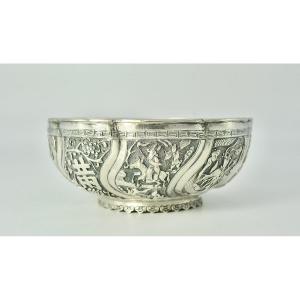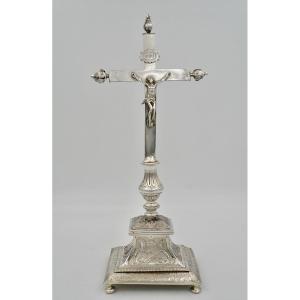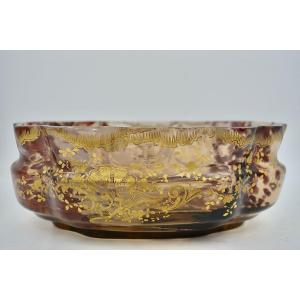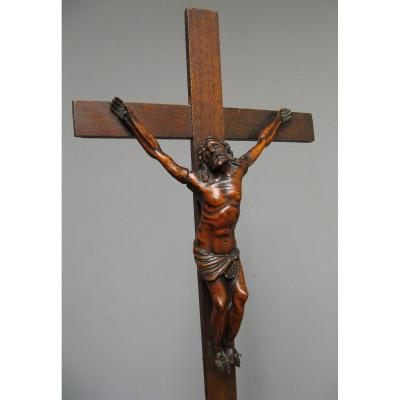The shaft of the chalice is made up of a knot in the shape of a Medici vase, decorated with palmettes and surrounded by several rings and collars decorated with a frieze of rosaries and ropes.
The cup of the chalice is gilded. It is set in an openwork saucer, supported by a corolla of palmettes and decorated with oval medallions in bas-relief representing the bust of Christ, the Virgin and Saint John, surrounded by garlands of vines, crowns of wheat and rosettes. This French chalice, inspired by the 18th century, was made during the first quarter of the 19th century in Paris by the great master goldsmith Jean-Charles Cahier (1801-1849).
Hallmarks: 950/1000 silver, head of Michelangelo (1819-1838).
Master goldsmith's hallmark: Jean-Charles Cahier.
Height: 28 cm
Diameter of the base: 13.7 cm
Cup: 9 cm
Weight: 555 g
The chalice is accompanied by a gilded silver paten from the same period, which fits perfectly to the cup of the chalice.
Paten: 950/1000 silver
Diameter: 13.9 cm
Weight: 70 g
The whole is in very good condition.
Chalice: some slight marks to report on the terrace and inside the cup.
Paten: traces of use.
Work of Jean-Charles Cahier, goldsmith at 34 quai des Orfèvres in Paris. His hallmark was inscribed in 1801 and struck out in 1849. Known for his famous works, such as the reliquary of the Holy Crown of Thorns of the Sainte-Chapelle in Paris or that of the Sainte Ampoule in Reims, he enjoyed great notoriety under the Empire and then under Louis XVIII and Charles X. He received numerous orders for religious goldwork in the provinces, notably in Languedoc for prestigious buildings such as the cathedrals of Saint-Nazaire in Béziers, Saint-Pons in Thomières, and Saint-Pierre in Montpellier, as well as collegiate churches such as Saint-Jean in Pézenas, or parish churches such as Saint-Paul in Clermont-l’Hérault.
/ French Ministry of Culture /


















































 Le Magazine de PROANTIC
Le Magazine de PROANTIC TRÉSORS Magazine
TRÉSORS Magazine Rivista Artiquariato
Rivista Artiquariato